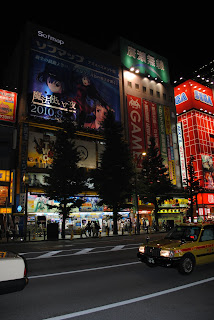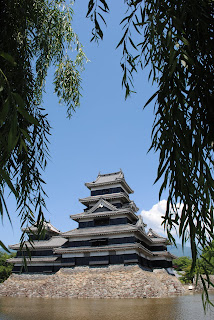
Earthquake information from the Japan Meteorological Agency this morning
The morning started inauspiciously when I was woken from my slumbers at 6 a.m. It was Raph: he was having a fit in bed next to me. It took a split-second to realise that it wasn’t Raph at all who was shaking, but the room - and it was all over, well, in two shakes. An hour later, I switched on the television and it was breaking news, with a webcam outside Tokyo showing some jittery images, followed by a map of the epicentre some 60 km north-east of the metropolis. At magnitude 5 on the Richter scale, hardly a major quake. Nevertheless - and this can be said now that I'm safely back on a continent where plate tectonics isn't a fact of everyday life – you can't really say you've been to Japan without having witnessed a tremor at first hand. It's just not the thing you want to be subjected to in bed on the fifth floor of a Tokyo hotel.

Raph on the Skyliner
Things didn't get much better. When you arrive at a railway station to catch a shuttle train for a flight at an airport 50 km away, the last thing you need - indeed the last thing you expect in Tokyo – is to see the words “Delayed” flashed all over the electronic information displays. We managed to solve this problem by jumping on the Skyliner Express train, more on our initiative than with the aid of railway staff who were not only confused themselves, but also as unhelpful as anyone we’d met in the last 3 weeks. The surcharge was 2400 yen, but as additional insurance against missing an intercontinental flight, it seemed like money well spent.

On time at the airport

Positively the very last Japanese train you'll see on this blog
Once we were checked in and through security and passport control, I toyed with the idea of buying a miniature plasticised meal as we spent our last yen on mementos. Fake meal displays outside Japanese restaurants are almost universal. Since restaurant menus are highly individualised, I had spent a disproportionate amount of time during the last three weeks pondering on how these menus are transformed into plastic. Is there a machine that frazzles meals into artificial replicas of the original? Are there businesses that specialise in the mummification process? Do special artists and designers exist who get a paid salary visiting eating establishments to discuss the options with the owners? And what happens when the chef decides to do a special? Whatever, in a country where English menus are few and far between, these visual displays can be extremely useful to the uninitiated.

Plasticised menu displays
The boredom of a ten-hour flight at least gave us the chance to catch up on some Japan reading. I finished reading Hokkaido Highway Blues by Canadian writer Will Ferguson which I'd been dipping into over the last three weeks. It's a 'Brysonesque' travelogue which relates Ferguson's efforts to hitch-hike from one end of Japan to the other chasing the Sakura (cherry-blossom) season as it makes its way northwards in the spring. Often hilarious, the book also had more serious, even philosophical asides and gives an insightful reflection on Japanese society.

The cherry-blossom forecast in 2009
Meanwhile in the next seat, Raph was heavily into A Very Brief History of Modern Japan which we had picked up at Kinukinaya yesterday. Later in the evening he'd discovered it had been written by one of his former lecturers on his Japanese course at Leiden. The flight back was otherwise excruciatingly dull and I spent what seemed many hours staring down at Siberia down below through the camera on the undercarriage.
After 3 intense weeks on the road living out of a suitcase, there’s been little time to reflect on the Japan experience. Whilst the blog paints a reasonably accurate picture of our time there, it’s just the tip of the iceberg and many questions remain unanswered (For example, how exactly do they plasticise their meals, and why do women (especially service staff) effect such a high-pitched voice?) There’ll be lots of time to reflect in the coming weeks. Right now I'm ready to have some major downtime in the comfort of my own home and catch up on lots of sleep (Raph is already doing so as I type this on the train back home).

Raph about to fall asleep in First Class











































